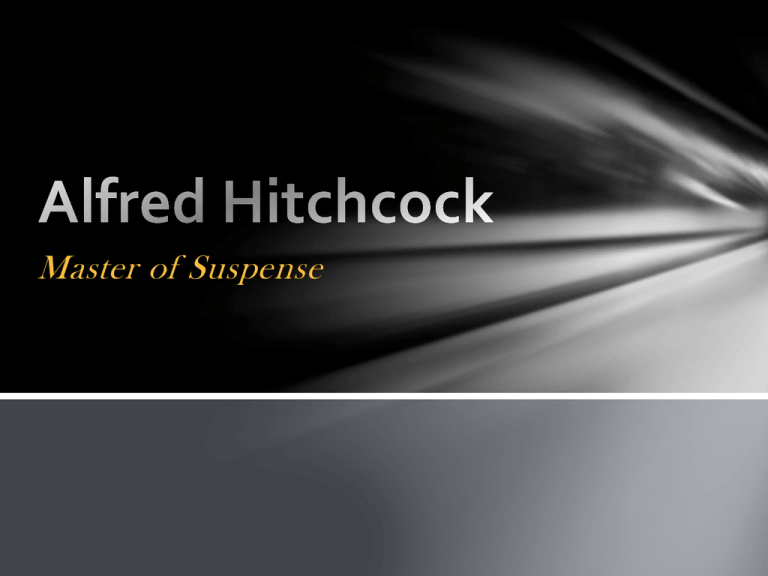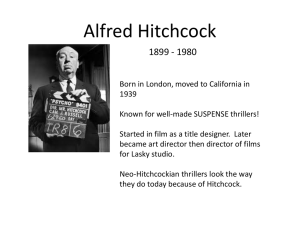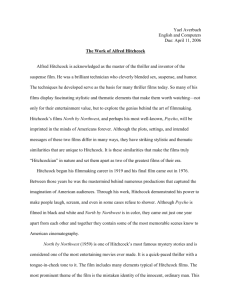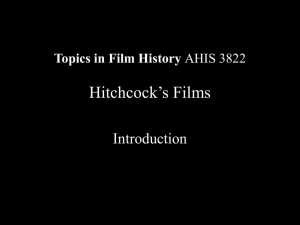Alfred Hitchcock
advertisement

Master of Suspense Alfred Hitchcock: Biographical Details NAME: Sir Alfred Joseph Hitchcock PLACE OF BIRTH: London, United Kingdom PLACE OF DEATH: Bel Air, California OCCUPATION: Director, Producer, Television Personality, Screenwriter BIRTH DATE: August 13, 1899 DEATH DATE: April 29, 1980 Alfred Hitchcock: Biographical Details •Alfred Hitchcock entered the film industry in 1920, writing scenarios and assistant directing. •In 1939 Hitchcock went to Hollywood, where his first film, Rebecca, won an Academy Award for best picture. •During the next three decades Hitchcock usually made a film a year, including the classics Rear Window and Psycho. •He received the AFI's Life Achievement Award in 1979 and died in 1980. Alfred Hitchcock and Auteur Theory Auteur theory , famously championed by such directors as Francois Truffaut, assumes that SOME films lend themselves to critical interpretation as the personal artistic expression of the “auteur” (French for “author”). This title can be applied to writers, cinematographers and even producers, but it is most often applied to directors (such as Steven Spielberg, Tim Burton, etc.). Alfred Hitchcock and Auteur Theory Auteur Theory is often expressed in a certain “look” or “flavor” that a particular film director or artists brings to a film. It is like their own, unique, artistic fingerprint on a film. Alfred Hitchcock and Auteur Theory Some mise-en-scene and other elements that lend themselves to critiquing Hitchcock’s films as the work of an auteur include: Voyeuristic roles of both the audience and the actor (Psycho and Rear Window) Innocent people caught up in complex, often uncontrollable situations (North by Northwest) Montages and German Expressionist influences in his editing and camera work (Psycho) Symbolic value in objects (knives and birds of prey in Psycho) Women (typically blonde) who are trapped / imprisoned and who act as victims or unpredictably – which might lend his films to feminist interpretation and occasional suggestions that Hitchcock’s films were sexist. Alfred Hitchcock and Auteur Theory There is one famous example of how Alfred Hitchcock sometimes may have regarded his actors as little more than set pieces (he often meticulously storyboarded his films, leaving virtually nothing for producers to change or cut). Since there were no alternative versions of his films due to extensive storyboarding, there was no way for producers to change it with additional shots. Allegedly, he was quoted as having said, “Actors are cattle,” or “Actors should be treated like cattle,” implying their primary role was to be herded from place to place by the auteur / director / Hitchcock himself. Actress Carole Lombard, in reaction to this comment by Hitchcock, brought cows to the first day of shooting on the film; Mr. and Mrs. Smith as a clever way of criticizing Hitchcock’s approach to actors – a criticism that may have been unfairly given, since Hitchcock generally got along fine with his actors. Partial Hitchcock Filmography (“Greatest Hits”) The Man Who Knew Too Much (1934 and remade in 1956) The 39 Steps (1935) Sabotage (1936) The Lady Vanishes (1938) Rebecca (1940) Suspicion (1941) Saboteur (1942) Notorious (1941 Lifeboat (1943) Notorious (1946) Rope (1948) Strangers on a Train (1951) Dial M for Murder (1954) Rear Window (1954) To Catch a Thief (1955) Vertigo (1958) North by Northwest (1959) Psycho (1960) The Birds (1963) Frenzy (1972) Hitchcock’s Definition of Suspense Paraphrasing Alfred Hitchcock’s definition of suspense, the film audience experiences suspense when: •The audience expects something bad to happen •The audience has (or believe they have) a superior perspective on events in the drama's hierarchy of knowledge. (referred to in literature as “dramatic irony”) •The audience is powerless to intervene to prevent the event (s) from happening. The Actor as Audience This voyeuristic / “helpless audience” element can be found in Hitchcock’s suspense films such as Rear Window. Jimmy Stewart’s Character (L.B. Jefferies) watches a neighbor’s apartment as he sits at home, laid up with a broken leg, unable to move. Later, he believes he sees a murder, but is unable to do much about it in his current condition. He can only watch and do nothing, like the typical audience watching a suspenseful film. The MacGuffin Alfred Hitchcock, at Columbia University in 1939, attibuted the idea of a McGuffin to his friend; Angus MacPhail. He described it with the following anecdote: Two Scotsmen are riding in a train. One asks the other what is contained in a package in the overhead luggage compartment. "It's a MacGuffin." "What's a MacGuffin?" "A device for hunting tigers in Scotland." "But there are no tigers in Scotland." "Well, then, it's not a MacGuffin, is it?" The MacGuffin A “McGuffin” is a goal, desired object or motivator that drives the protagonist or the plot of a film forward. These are frequently used to heighten suspense. It is often important both to the characters and the audience, but may diminish or disappear from importance by the end of the film. Some MacGuffins in film include: The $40,000 stolen by Janet Leigh’s character Marion Crane in Hitchcock’s film; Psycho. Marion Crane herself, following her death, in Hitchcock’s film; Psycho The microfilm sought by the antagonists in Hitchcock’s film; North By Northwest George Caplan, a fictional spy for which Roger Thornhill is mistaken in Hitchcock’s film; North By Northwest Uranium-filled wine bottles in Hitchcock’s film; Notorious The MacGuffin Some other, non-Hitchcock films that include a MacGuffin include: The sled Rosebud in Orson Welles’ masterpiece film; Citizen Kane The mysterious briefcase that glows a golden glow when opened in Quentin Tarantino’s Pulp Fiction The titular item in John Huston’s Film Noir; The Maltese Falcon. It is described as , “It’s the stuff that dreams are made of.” The Ark of the Covenant in Steven Spielberg’s film; Raiders of the Lost Ark (also the Holy Grail in Indiana Jones and the Last Crusade) The death star plans in George Lucas’ film; Star Wars The “Ring of Power” in Peter Jackson’s film adaptations of J.R.R. Tolkien’s novel trilogy; The Lord of the Rings Unobtanium (get it?) in James Cameron’s film; Avatar The Wrong Man A common conceit in Hitchcock films, the protagonist is often mistaken for someone else, which leads to suspenseful circumstances. For example, Roger O. Thornhill (played by Cary Grant in his classic film, North By Northwest) is mistakenly believed to be someone he is not and becomes involved in a web of kidnapping and murder. The Wrong Man The “wrong man” character often heightens the suspense within a film, as they are frequently innocent people caught in circumstances beyond their control or understanding. The 39 Steps (1935) The Wrong Man Other Hitchcock films that contain the “wrong man” character include: •The 39 Steps (1935) •Young and Innocent (1937) •Saboteur (1942) •To Catch a Thief (1955) •Frenzy (1972) The Identification of Suspense When applying the title of “suspense” to films, these types of films might be characterized or described by critics as: A distinct genre, such as Horror or Sci-Fi A cross-genre element, such as a “Mystery / Suspense” film or a “Detective / Suspense” film A “Thriller” Sources Cited "Sir Alfred Hitchcock." 2012. Biography.com 29 Mar 2012, 03:20 http://www.biography.com/people/alfred-hitchcock-9340006 Hitch: The Genius of Alfred Hitchcock / Hitch: Alfred the Great. Films for the Humanities & Sciences, 2004. Film. Hitch: The Genius of Alfred Hitchcock / Hitch: Alfred the Auteur. Films for the Humanities & Sciences, 2004. Film.









